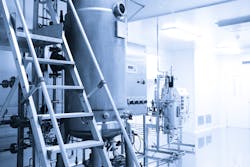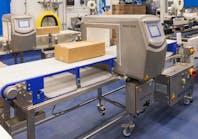Many sophisticated tools exist for measuring the conditions inside a cleanroom facility. These tools, their precision readings and the monitoring they allow, are essential to keep the equipment and conditions up to the required standards for cleanroom operation.
Different facilities have different needs for their cleanrooms, in terms of equipment, scale, allowable vibration and accuracy of ambient conditions in the room.
The monitoring of these conditions will also depend on how the cleanroom is used. Depending on how strict the standards are for the facility and how large the space is, leaders have a variety of choices for how best to manage conditions within the cleanroom.
Vibration is one of the most significant disruptive factors that can compromise a cleanroom and potentially damage equipment or affect product. Effectively resolving vibration issues can present difficult challenges that do not have clear paths to resolution. What is the source of the vibration? How is the vibration effectively counteracted? Or, how can a project leader significantly reduce vibration?
Decisively navigating the path to identify the source of the problem involves savviness and clarity, while solutions necessitate in-depth understanding of both infrastructure and equipment.
Here are insights.
1. Locate the source of vibration
Vibration is caused by something moving or rotating. Before a vibration problem can even be addressed, the source of the vibration must be located, which can be a challenge. Looking at the different vibration frequencies can help identify the source of the vibration and address it.
Typically, the process of elimination starts with checking the operating frequencies of pumps, fans and other moving equipment. The frequency of operation and the vibration frequency will match up if that equipment is the source, so it is necessary for the technician to be well-versed in reading and analyzing the data. Once a match is identified, it will be possible to isolate the source of the vibration.
Because there are many potential sources for the vibration, it can be challenging to make that connection. Many times, an amplitude change will lead back to the source but because of the way the building is constructed, what appears to be the source of the vibration might actually be amplified over the span of the structure, making it more difficult to isolate. In those cases, it is necessary to follow an effective troubleshooting process to locate the source. This process starts in a wide circle and works its way inward toward the center of the structure until the source is isolated.
The key to this is understanding how to determine where the vibration is the strongest and follow the clues in the process that lead to the source. In some cases, it is fairly easy to track down using these methods, whereas in others — for example, if the vibration is three stories down — a more stringent process is required to find the source. With the high-tech equipment available today, it is often possible to get an instant reading with handheld modules that laypeople can interpret, saving the time and cost to hire vibration analysis experts, who are very rare and specialized.
2. Counteract vibration
Once located, there are various methodologies for counteracting vibration. One of the most common approaches is to use springs or flex connections. There are different tensions and weight characteristics for various springs, so it is important to have all the data to optimize the solution for the particular facility and equipment. If applying this approach to an entire system, the springs are installed on the duct work to isolate vibration away from other structures, allowing the duct to move slightly without disrupting the surrounding structure. Air bearings, flex connections and various types of shims can also be used depending on the vibration levels. Like springs, flex connections must also be chosen with care as they are designed with varying levels of stiffness. Choosing a flex that is too stiff can actually make the vibration worse, so engineering the selection of the proper flex connection for the application takes experience and knowledge.
3. Significantly reduce vibration
There are some unique challenges to reducing vibration under special circumstances. With smaller equipment, for instance, there are more complex issues to consider. There is special equipment to measure the vibration on smaller tools, and technicians need to know how to use that equipment correctly and how to interpret the data from it. Typically, they are looking for frequency changes over time. The frequency is monitored — continuously or on a cadence —as the technician looks for changes in that session. Even the smallest changes in frequency can be indicators of bearings inside the equipment going bad or small pieces of debris caught in a pump. With a baseline for normal operations, it is easier to see slight deviations early and address the potential problems they may indicate before they cause damage. Finding the optimal solution for the equipment and the level of vibration requires a unique approach to every case.
It often surprises leaders and technicians how complex these processes can become. Technicians will see that equipment runs at different levels every day, so vibration changes based on ambient conditions and the demand on the system. In the case of a pump, for instance, if demand goes up, the speed of the pump will go up and the vibration may disappear completely. Then, when the demand tapers, the speed slows and it starts vibrating again. One of the biggest challenges is knowing when to question these findings in light of such circumstances.
It takes experience to analyze various vibration changes and to determine which are indicative of deeper issues and which are the result of a small change in operating or ambient conditions. This type of precision is critical in the cleanroom environment, where equipment and environmental conditions are closely monitored to maintain the strict level of sterility required for special operations and data collection.
4. Plot the path
Project stakeholders look to team experts to understand vibration challenges in light of varying needs for their cleanrooms in terms of lab equipment and vibration tolerances. Effectively resolving vibration issues can present arduous situations with no clear process to a solution. Plotting the path to identify the source of the problem involves insight because developing solutions relies on intimate familiarity with cleanroom facilities, buildings, systems and equipment.
Dewayne Galyon is a technical specialist and associate at SSOE Group, a global project delivery firm for architecture, engineering and construction management. With nearly 30 years of experience, Galyon leads, performs and participates in reviews of multidiscipline projects, critical investigation boards, operational readiness reviews, facility turnover and startup, environmental compliance assessments, and time and materials estimates. He can be reached in SSOE’s Hillsboro, Oregon office at 503 213-4250 or [email protected].



